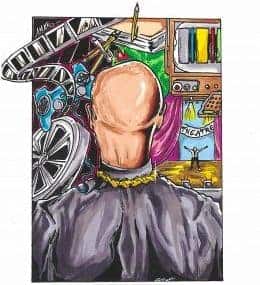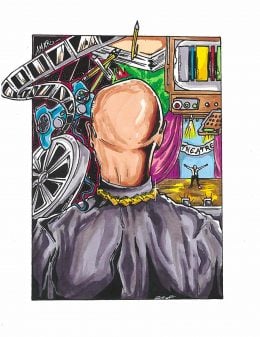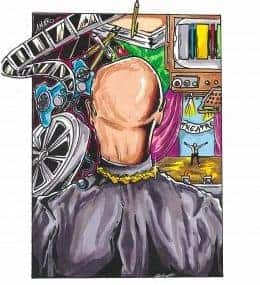The Handmaid’s Tale: Season 1/ Episode 3 “Late” – Overview/ Review (with Spoilers)
As it’s revealed what happens to those like the original Ofglen, June continues to try to navigate through a world in which she finds herself to be the lobster in the boiling pot. It All Started Little By Little: June, Moira A terrorist attack in Washington D.C., a few laws passed, and then suddenly…

Spoiler Alert: This summary and review contains spoilers.
Additionally, some images and text may include affiliate links, meaning we may earn a commission or receive products if you make a purchase.
As it’s revealed what happens to those like the original Ofglen, June continues to try to navigate through a world in which she finds herself to be the lobster in the boiling pot.
It All Started Little By Little: June, Moira
A terrorist attack in Washington D.C., a few laws passed, and then suddenly the birth of The Eye and women finding themselves let go in mass. On top of that, their banking accounts frozen and their husbands, or male next of kin, are to have the money transferred to them. As you can imagine, this leads to protest. However, as the protestors get aggressive, so comes out the machine guns and not only are either people shot but a grenade launcher or something a bit more devastating gets used to maintain control.
Commentary
If has not been forgotten that Janine said Moira is dead and I was so hoping when we saw Emily in the episode we would have gotten some glimpse of Moira. Alas, we only see her in the past. Which really is something when you consider it. Some group, which still is not that developed or established, in terms of understanding their rise to power or who they are, outlaws women working and managing their own finances.
Now, like many, I can’t imagine that happening. Yet, just this last weekend, we had another sort of warning of what some may seem like an impossible future in The Circle. Both rely on this idea that good people wouldn’t let the end of privacy or autonomy come about. However, in both, it seems firmly established that there is a world of difference between those willing to march and get active and those who hope for the best and vent about the worse. All the while, the world changes, little by little, and they just settle in thinking someone they elect, a friend, or some activist will take care of things.
Yet, in both cases, we get to see what happens when you rely on others to determine your fate even as it becomes clear that things will only get incrementally worse.
The Benefits of People Thinking You’re Pregnant: June
Getting pregnant is a big thing. You are exalted in a way, especially if you have a healthy baby. With that, the few remaining luxuries of the world are yours and you receive the last remnants of kindness, that might be genuine, left in the world. However, June isn’t pregnant. With that, Serena Joy goes from this very kind woman, one who stops June being interrogated and abused by Aunt Lydia, to an almost wicked stepmother in a children’s fairytale.
Commentary
With Serena Joy establishing that she did try to get pregnant at one time, only to discover she can’t, it sort of ruins the hierarchy idea I had. However, it doesn’t necessarily clear up how does one become a handmaiden, chosen to be a wife, and what have you. You’d think Handmaidens would be chosen like Janine and June because they had children in the past, but then Moira kind of ruins that theory.
But what is clear though, based on how Janine’s mistress, once you have your child you are given time to rest but then you could easily get sent off to your next assignment. For while there seems to be a population shortage, what woman is really going to put up with a Handmaiden like Janine? Especially one who is not only fertile but younger, some semblance of attractive, and maybe even a better lay?
Though, handmaiden stuff aside, it was interesting to see The Eye at work, much less see Aunt Lydia as their sort of enforcer. But, at this point, I’m starting to believe she is just responsible for all handmaidens in the area and any business dealing with them, she is to be present. That thought aside, seeing them work and interrogate wasn’t as fearful as I was expecting. I was thinking they’d take her to some police investigation room which you could hear muffled noises in the back and they really set this deserved tone of fear you know? However, being that The Eye is mostly silent, and covert in a way, you come to realize that wouldn’t be the best way to operate. They are observers, sometimes the hand of god, but like our current police force, for some, their real job is being a deterrent for crime.
Really leading me to wonder, with it seeming like the world has trained so drastically, how does one become a member of The Eye or like Aunt whoever? Though we have been given such a large world, it still very much feels like we are seeing but a satellite image and aren’t zoomed in on any particular detail really. At least when it comes to things which don’t deal with giving childbirth.
Leading to one last question for this topic: What are the children being trained to do in school now?
What Happens to Gender Traitors: Emily (Formerly Known as Ofglen)
Ofglen, who Aunt Lydia reveals the true name of: Emily, is seen. Her as well as her lover Martha. Now, being that Martha can’t have children, she is hung. As for Emily? Well, the court, which is without a jury and simply has a judge and witnesses, sentences her to redemption. Which, from the looks of it, maybe female genital mutilation.
Commentary
One thing I have been a bit confused about was the significance of names on this show. Especially the changing of them since, for the most part, none of these names sounded anything but white American. We have June, Emily, Hannah, and generic names like that. It isn’t like Moira, which isn’t as common, and certainly nothing which has a sort of “other” vibe. But it seems that names are almost like titles in their world. It isn’t like some sort of Ellis Island thing where your new name is made to allow for assimilation but is like an ID number of some kind.
The whole name thing aside, I was really hoping we would have gotten to see colonies. For while, I get, too much too soon, they have to string this along since this is perhaps one of the first Hulu productions that is really noteworthy and wholly original [note]as in it wasn’t ported from a different station[/note], I’m excited. Not on the level that Anne had me excited, but this is a distant 2nd. Making me somewhat peeved that we’ll actually have to wait one week for each episode yet, at the same time, it gives us all something to look forward to.

